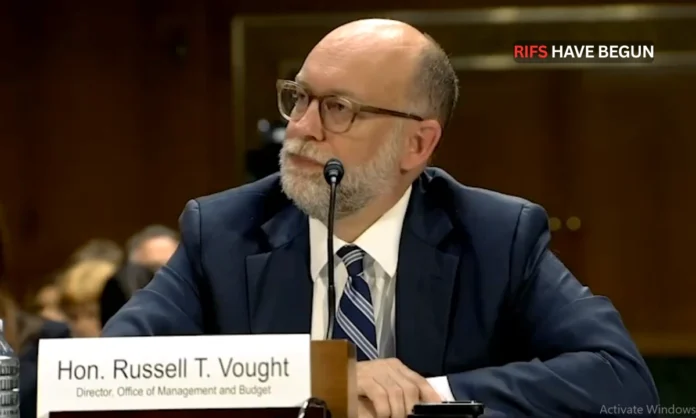Key Highlights:
- More than 4,000 federal employees across seven agencies received layoff notices on October 10, 2025
- Treasury and Health and Human Services departments face the largest cuts, with over 1,100 employees each affected
- Federal workforce has already been reduced by approximately 200,000 positions since Trump returned to office in January 2025
The Trump administration federal layoffs have commenced in earnest, marking an unprecedented escalation during the ongoing government shutdown that began October 1, 2025. Office of Management and Budget Director Russell Vought announced on social media that “the RIFs have begun,” referring to reductions-in-force that target thousands of federal workers across multiple agencies. These Trump administration federal layoffs represent a dramatic departure from typical shutdown protocols, where employees are usually furloughed temporarily rather than permanently terminated. The initiative reflects President Trump’s long-standing commitment to reducing federal government size while leveraging the shutdown as an opportunity to implement comprehensive workforce restructuring.
Scope of Federal Employee Terminations
The scale of these Trump administration federal layoffs became clearer through court filings revealing that at least 4,000 federal employees received termination notices on October 10 alone. The Treasury Department faces the most significant impact with approximately 1,446 employees receiving layoff notifications, while the Department of Health and Human Services follows closely with between 1,100 and 1,200 affected workers.
- Department of Education and Housing and Urban Development each plan to terminate at least 400 employees
- Departments of Commerce, Energy, and Homeland Security target cuts ranging from 176 to 315 employees each
Additional agencies affected include the Environmental Protection Agency, where 20 to 30 employees received “intent to RIF” notices, signaling potential future Trump administration federal layoffs. White House budget office officials confirmed these initial terminations represent only the beginning, stating that “more RIFs are coming” as agencies continue evaluating workforce optimization strategies.
Legal Challenges and Union Opposition
Federal employee unions have mounted immediate legal resistance to these Trump administration federal layoffs, filing lawsuits challenging the administration’s authority to conduct mass terminations during a shutdown. The American Federation of Government Employees and AFL-CIO filed suit in federal court in Northern California, seeking a temporary restraining order to halt the layoffs. AFGE President Everett Kelley condemned the actions as “disgraceful,” emphasizing that federal workers provide “critical services to communities across the country”.
- Legal experts argue the shutdown does not grant additional authority for workforce reductions
- Federal law requires minimum 30-day notice periods before implementing layoffs
- Court hearings on union restraining order requests are scheduled for mid-October
The Partnership for Public Service has criticized these Trump administration federal layoffs as undermining federal government capacity and stripping away essential expertise. Legal challenges focus on whether the administration has legitimate authority to conduct permanent terminations rather than temporary furloughs during funding lapses.
Federal Workforce Reduction Statistics
Official data from the Office of Personnel Management reveals the broader context of Trump administration federal layoffs within systematic workforce reduction efforts. As of March 31, 2025, federal civilian employment stood at 2,289,472 employees, down from 2,313,216 on September 30, 2024, representing a reduction of over 23,000 positions. The Partnership for Public Service estimates approximately 200,000 federal workers have departed since Trump resumed office in January 2025.
Recent employment statistics demonstrate accelerating workforce reduction trends under current policies. Federal employment dropped from 2,978,000 positions in April 2025 to 2,918,000 by August 2025, reflecting a loss of 60,000 positions in just four months. The administration’s hiring freeze contributed significantly to these reductions, cutting monthly new hires from nearly 23,000 to just 7,385 per month.
| Agency | Layoff Notices | Percentage of Workforce |
|---|---|---|
| Treasury Department | 1,446 | 2.1% |
| Health and Human Services | 1,100-1,200 | 1.8% |
| Department of Education | 400+ | 3.2% |
| Housing and Urban Development | 400+ | 4.1% |
Economic and Political Implications
These Trump administration federal layoffs occur amid a government shutdown affecting approximately 750,000 workers through furloughs and unpaid leave arrangements. Congressional Budget Office analysis of previous shutdowns indicates each week of reduced government activity typically reduces annualized GDP growth by 0.1 percentage points. The current shutdown, combined with permanent workforce reductions, could amplify economic disruptions beyond historical precedents.
Political tensions have intensified as Democrats accuse the administration of creating “deliberate chaos” through these Trump administration federal layoffs. Republican leaders defend the strategy as necessary government streamlining, with Senator John Thune noting the administration had to “prioritize where they’re going to spend money when the government is shut down”. The administration frames these reductions as implementing efficiency measures and optimizing workforce operations during funding lapses.
- Challenger, Gray & Christmas reported 299,755 planned government job cuts in 2025, with 289,363 attributed to Department of Government Efficiency initiatives
- State-level impacts vary significantly, with Maryland and Virginia experiencing the highest net federal job losses at 5,900 and 5,100 positions respectively
- Federal employment comprises nearly 2% of all non-farm employment nationally, making workforce reductions economically significant
Closing Assessment
The Trump administration federal layoffs represent a fundamental shift in how government shutdowns affect federal workforce stability, moving beyond temporary furloughs to permanent terminations across multiple agencies. With over 4,000 employees already receiving layoff notices and officials promising additional reductions, these Trump administration federal layoffs signal the most aggressive federal workforce restructuring in recent history. Legal challenges from federal employee unions and congressional Democrats highlight the contentious nature of using shutdown periods to implement permanent workforce changes.
The broader implications of these Trump administration federal layoffs extend beyond immediate job losses to questions about federal government capacity and service delivery capabilities. As court battles continue and additional termination notices loom, the ultimate scope and legality of these workforce reductions remain subjects of intense political and legal scrutiny. The administration’s commitment to further Trump administration federal layoffs suggests this represents only the initial phase of comprehensive federal government restructuring efforts.


